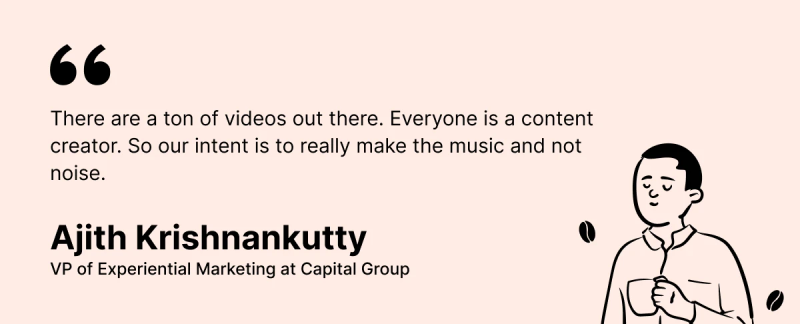The Power of Using Videos as Part of Your Marketing Strategy and 5 Tips To Get Started

Table of Contents
Maximize Your Marketing ROI
Join 10,000 other marketers already getting the best tips on running engaging events that boost pipeline and create raving fans.
Nothing makes us happier than enjoying a refreshing jolt of caffeine with other marketers while we talk about what's going on in the industry. If you tuned in for the first installment of our four-part series, Coffee Corner, you were in for a nice treat to go with your morning cup of Joe!
Our expert panel for the inaugural event consisted of:
- Belinda Joseph, Head of Events and Community, Goldcast
- Sarah McConnell, VP, Demand Generation, Qualified
- Ernest Owusu, Senior Director of Sales Development, 6sense
- Ajith Krishnankutty, VP, Experiential Marketing, Capital Group
As a group, the four leaders talked about companies with noteworthy video marketing efforts, some best practices around video marketing, and more.
Read on to discover:
- Your customers want video content
- Great video examples from brands on social media
- 5 tips for creating best-in-class video content of your own
- Case study: Capital Group uses videos to humanize financial services content
- Get those ideas brewing for the next Coffee Corner ☕
Coffee Corner is presented by Goldcast, 6sense, and Qualified—save the date for the next episode coming on May 15, when we talk about intimate in-person events and why they might be a good choice for your company.
And if you want to watch the full replay, you can do that below as well!
Your customers want video content
There's tons of evidence out there that your customers want you to create videos. Take these stats from Wyzowl:
That's right: 91% of consumers surveyed would like to see more online video content from brands. That's almost everyone, and if you think about it, don't you gravitate more to video content than to text?
In general, marketers are already trying to meet those expectations, with 86% reporting that they're currently using video as a marketing tool and almost all of them seeing good ROI from those efforts. Encouraging news on all fronts, we think!
Great video examples from brands on social media
According to a poll we took during Coffee Corner, most people are using their video content on social media. This makes sense; social is a great way to dip your toe in the video waters and see what works in a relatively low-stakes way. Here's some inspo to pull from!
Sendoso's inclusion of children to launch Party Links
If you want an example of a company doing this well, Belinda loves Sendoso's LinkedIn. Check out the way they involved the whole family to introduce their Party Links:
Because Sendoso is a swag and gifting platform (and one we use ourselves at Goldcast), it's super fun to see the videos they share of people unboxing their gifts.
A video like the one above is such a fun way to get people interested in what you're up to and show them how it feels to be a customer. Sendoso is super smart about creating a variety of content, from BTS sneak peeks to how-to videos to quick educational videos.
Clue's generation-spanning educational videos
Another company with a wide range of video content is Clue, a period and ovulation tracker and app. They use video for product announcements and demos, which many companies do—however, an area Sarah felt Clue stood out the most is in bringing personality-driven videos that share about the specific pain points or interests of the company's ICP.
Case in point: This video on Instagram that talks about perimenopause and how it can last 10 years or more. For many people with periods, perimenopause and menopause itself are not talked about enough, and Clue is helping to educate its audience on these topics via engaging, trendy video content that destigmatizes what can often be challenging healthcare topics.
ZoomInfo's "Day in the Life" series
Here's another example, this time from ZoomInfo, featuring a day in the life of one of their SDRs:
This video capitalizes on people's curiosity about other people's routines and job roles. It humanizes John, the ZoomInfo SDR, and makes the company stand out from its competitors as relatable. And it's not product-heavy by any means, but it still succeeds in getting ZoomInfo on everyone's radar.
Gong on how they use Gong
Finally, Ernest called out Gong for doing an awesome job with video content. Take a look at this video, in which an account executive at the company shares how he uses Gong's Ask Anything feature to solve issues with his own workday:
A company employee talking about how they use the company product in a way that doesn't seem rehearsed? We're here for it! Sure, you can share about a feature in a standard post, but someone actually appearing on video to show you firsthand how they use a tool is more compelling, in our opinion.
5 tips for creating best-in-class video content of your own
Now that you've seen some cool examples, let's talk about how you can develop strong videos of your own. With so much digital noise out there, plus the fact that people's attention spans seem to be shrinking by the day, how can you hold people's attention?
Segmentation comes first

Segmentation can help you identify which types of videos to create and what the respective goals will be. For example, if you identify that your customers want to know how to start using your product, that's going to be a very different video from the one someone would need if they want to get better as a current product user.
As Sarah points out, trying different things is part of the process, and you'll likely have to use different formats and channels. What speaks to your younger audience on TikTok probably isn't going to resonate with your execs who hang out on LinkedIn, so you'll need to create content for both groups.
Test your video content against brand guidelines
Historically, B2B content has been a bit more polished than B2C, so it's been interesting to see the shift toward more casual, "real" B2B content. However, you still want your content to be on brand, which you can accomplish by evaluating videos against your established brand guidelines.
And if you don't have brand guidelines set up yet, try sending your videos to a few people across different departments and asking them for their feedback. Ask folks if the videos resonated or felt true to your brand. This can help you get an idea of how the video is landing with people who have different POVs and get outside the echo chamber of just your team.
Invite influencers to your campaigns
![[object Object]](https://cdn.sanity.io/images/2939l4aj/production/b3a545d22368123fb622750e1d6df8f10e117aa9-1200x486.webp?w=800)
The 6sense team sees a big difference when they lean on videos that have subject matter influencers; people like to learn from others who are doing their job and, according to 6sense data, they engage more with content featuring influencers.
That said, influencers in the B2B space are very different from those in B2C. You have to make sure that whoever you partner with understands your brand and the way you speak about it, which is why working with internal influencers is oftentimes the best place to start since they already know your product.
Don't forget about your customers as organic brand reps
Speaking of influencers….Belinda shared a great story about how your customers can be the best salespeople ever:
Capturing some of these authentic moments on video and then repurposing them (bonus points if you're using Goldcast Content Lab to do so!) to promote across channels can really bolster your credibility. People don't always want to hear a sales pitch, and they tend to believe other people more than they do companies.
Keep your sales team in the loop
Finally, the resident sales expert wanted to remind everyone of a critical point: Inform your salespeople about what's going on with your video efforts!
Make sure that your salespeople know what type of video content your customers are engaging with; this can help them drive conversations and nudge deals forward. This can be especially helpful when a conversation stagnates because it gives the salesperson something new and fresh to talk about, reigniting the discussion.
Case study: Capital Group uses videos to humanize financial services content
Ajith Krishnankutty, VP of Experiential Marketing at Capital Group, joined the stage to talk about how he's been using content to humanize the very technically complex financial services world. Whether it's investing in a broadcast studio or launching a new podcast, The Capital Ideas Investing Podcast, Ajith has his hands full!
Because he took the team over right before COVID hit, Ajith was grateful to stumble upon OpenReel, a solution that allows you to create high-quality video content across the world—a must for those virtual-first times.
But he didn't stop there. He went on to create a broadcasting studio, which originated as just a big, CNN-style room with a green curtain as the background where Ajith could virtually invite guests.
Having the tools and space to create content was one thing, but Capital Group recognized early on that they needed to partner with an agency who could help them broadcast their videos in a scalable way, rather than hire a bunch of new talent. (Great reminder to outsource whenever it makes sense!)
Right now, Ajith spends a lot of time thinking about how to humanize Capital Group's video content. The company's new CEO actually came up with an idea to host a series called Conversations with Mike Gitlin, in which he interviews one of the company's portfolio managers about a topic. Spending half an hour listening to these leaders talk about trending topics is a great approach to giving the audience a face and story to connect with.

Once any video content is created, Ajith repurposes it and distributes it across channels, from YouTube to social media. The goal is to meet clients where they are and take the content to them, versus expecting people to come to the company website (this may have worked in the past, but it's not a great strategy now).
Get those ideas brewing for the next Coffee Corner ☕
We hope to see you, mug in hand, for the next episode of Coffee Corner!
Stay tuned for more event info to come, and don't forget to watch the full replay of our first session below to go beyond what we covered here, including tech tool recommendations our panel is currently using. Let us know what you think on social, and we'll see you soon!
![[object Object]](https://cdn.sanity.io/images/2939l4aj/production/c470d1f15ad3f7e88cbbc800c1ba58874752c50f-1200x350.webp?w=800)
Stay In Touch
Platform
Resources
Company
Community
© 2025 Copyright Goldcast, Inc. All rights reserved.



 Upcoming Events
Upcoming Events Event Series
Event Series On-Demand Events
On-Demand Events

